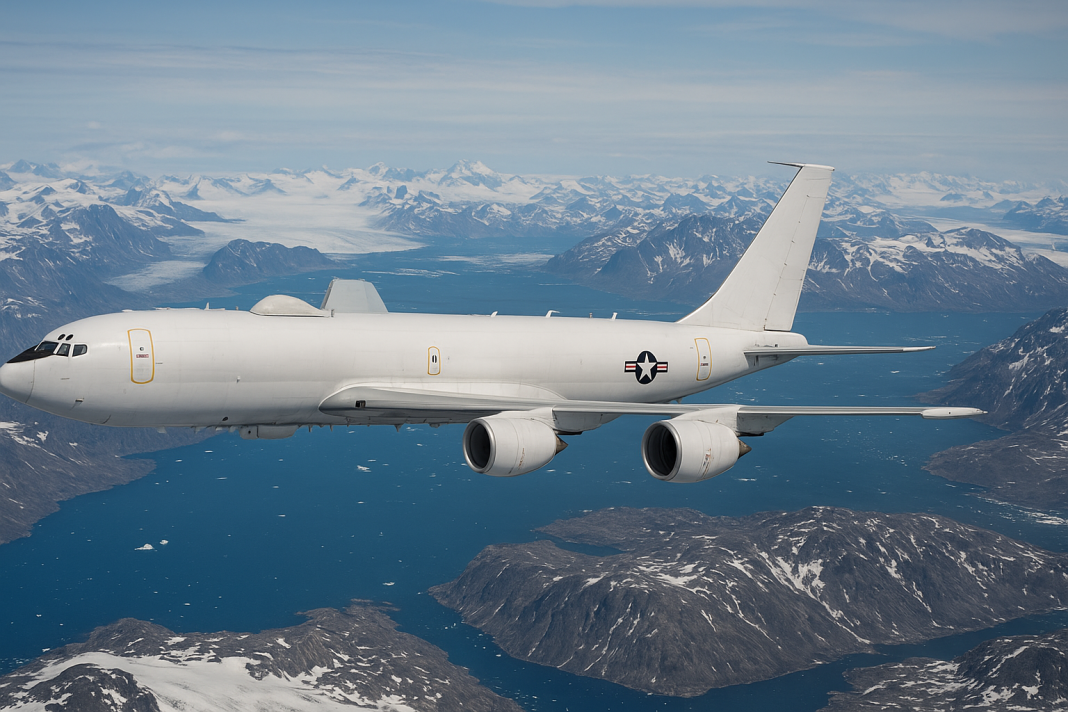A United States military command aircraft capable of communicating with nuclear-armed submarines was recently tracked on an unusual mission near Greenland. The aircraft, known as the E-6B Mercury, is one of the most critical components of America’s nuclear communication system.
Strategic E-6B Aircraft Spotted in Rare Arctic Operation
According to the U.S. Navy, the E-6B was deployed to Pituffik Space Base in Greenland. Officials described the mission as part of “routine operations,” involving coordination with nuclear submarines across the Pacific and Atlantic Oceans.
The flight caught attention because the E-6B is rarely seen in this part of the Arctic. The mission was recorded by open-source flight trackers, which followed the plane as it operated for several hours over the Labrador Sea, west of Greenland. Experts highlighted the mission as unusual since deployments of this aircraft to Greenland have not been noted before.
🇺🇸🇩🇰 America Eyes Greenland Again — Not to Buy, But to Back Strategic Expansion
Pituffik Space Base is a key American installation in the Arctic region. It houses powerful radar systems that monitor missile activity and provide early warning in case of potential threats to North America. The E-6B’s deployment to this base underscores the importance of the Arctic in global military operations.
What the E-6B Aircraft Can Do
The E-6B Mercury plays a central role in the United States’ nuclear command and control structure. This aircraft is designed to act as a communication bridge between the nation’s top leadership and its strategic nuclear forces.
It carries a very low frequency communication system that allows it to send signals to submarines deep under the ocean. To do this, the E-6B can deploy special trailing antennas, with the primary one stretching up to five miles long. This enables the plane to transmit secure messages even to submarines hidden beneath the sea.
Foreign Powers Threatened as Greenland Cracks Down on Foreign Interference in Elections
Besides communicating with submarines, the E-6B can also control intercontinental ballistic missiles. It is equipped with the Airborne Launch Control System, which is designed to transmit launch codes to land-based missile silos if ground control centers are destroyed or disabled. This ensures that communication with strategic weapons can continue even in the worst scenarios.
The aircraft is part of the U.S. Strategic Communications Wing based at Tinker Air Force Base in Oklahoma. While it is usually stationed there, the E-6B is often forward-deployed to other locations. In recent years, it has been seen operating from bases in Europe, Guam, and the United Kingdom. However, its movement to Greenland stands out as a rare occurrence.
Why This Flight Stands Out
The recent mission near Greenland was not the first time the E-6B has drawn attention. Last month, the aircraft was seen working alongside the nuclear-powered submarine USS Maryland in the North Atlantic. Such operations are usually confirmed by the Navy as part of exercises with allied forces.
In the latest case, the flight from Pituffik Space Base was tracked for several hours over the Labrador Sea. Analysts who follow military aviation called the mission unusual, suggesting it was either part of communications with a submarine or another type of exercise.
Greenland is considered a vital location for U.S. defense. The base there operates the Upgraded Early Warning Radar, which detects and tracks intercontinental and submarine-launched ballistic missiles. This radar provides critical data for protecting the U.S. homeland.
The unusual nature of the E-6B’s Arctic flight lies in the fact that the aircraft has rarely, if ever, been deployed to Greenland before. Records show it has been deployed to several other nations, but Greenland appears to be a new addition to its operational locations.
🚨 Fake Facebook Post Claims Danish Lawmaker Turned to Russia to Block U.S. Grab for Greenland
The E-6B fleet has been in service for decades, with the first aircraft accepted into service in the late 1990s. The planes were upgraded to the E-6B configuration by 2003, giving them the dual mission of submarine communication and missile launch control.
Defense experts describe the role of the E-6B as one of the most serious in the world. Its mission ensures that the United States retains the ability to communicate with its nuclear forces under any conditions. Although the aircraft’s work is rarely seen by the public, its presence in Greenland has highlighted just how global and far-reaching these operations can be.

